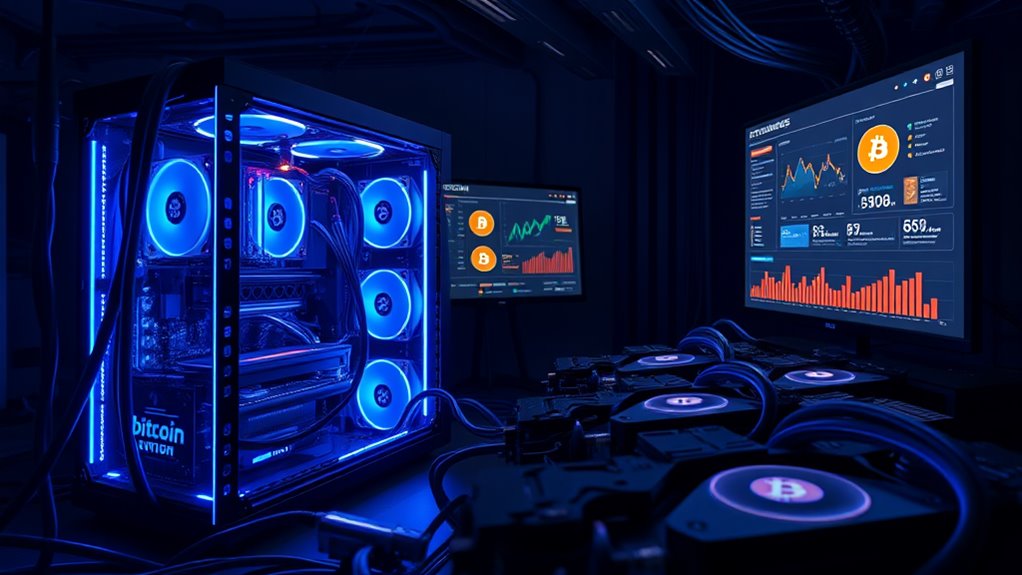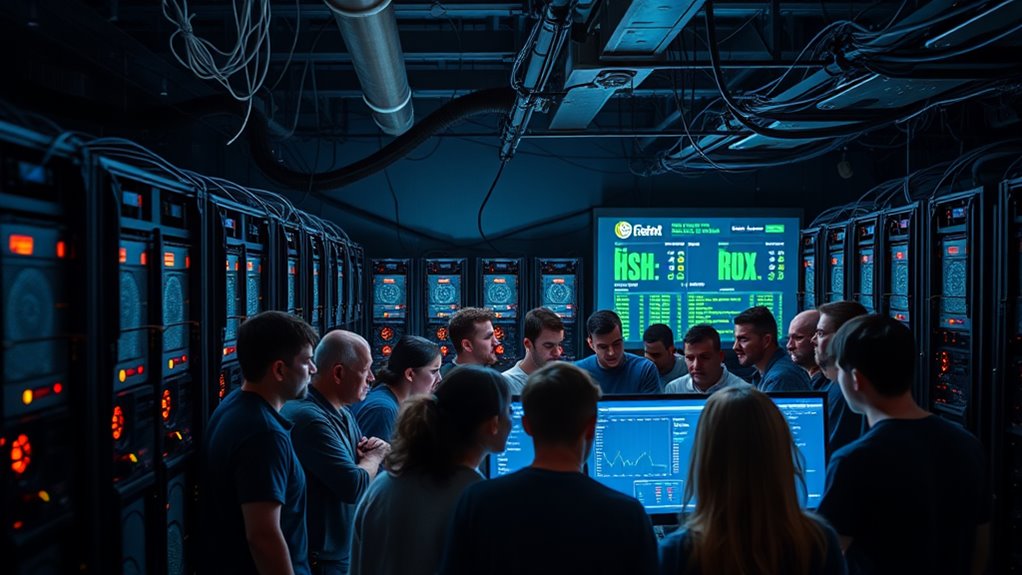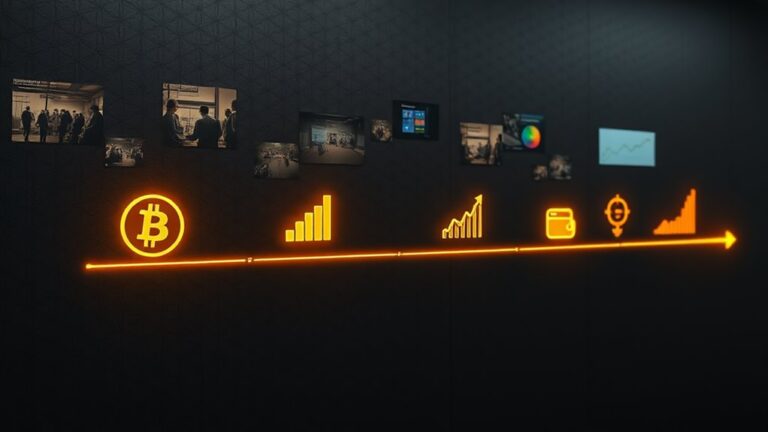
Bitcoin Mining: How It Works?
Bitcoin mining is the process where specialized computers solve complex cryptographic puzzles to verify transactions and add them to the blockchain. Miners collect transactions, validate them, and compete to find a solution by adjusting a value called a nonce until they produce a hash below a target threshold. Successful miners receive rewards of 6.25 BTC plus transaction fees. The system has evolved from CPU mining to energy-intensive ASIC hardware, with difficulty adjusting automatically to maintain security. Further exploration reveals how this process maintains Bitcoin's decentralized nature.
Key Takeaways
- Miners verify transactions, solve cryptographic puzzles called Proof of Work, and add valid blocks to the blockchain.
- Successful miners receive block rewards (currently 6.25 BTC) and transaction fees as economic incentives.
- Mining difficulty adjusts every 2016 blocks to maintain consistent block creation despite changing network computing power.
- Hardware evolved from CPUs to specialized ASIC miners, increasing efficiency by up to 100 billion times.
- Mining requires substantial electricity, with miners joining pools to increase chances of earning rewards amid growing competition.
Bitcoin Mining: How It Works?

How exactly does the complex process of Bitcoin mining function in the digital economy? Bitcoin mining begins with transaction collection, where miners gather pending transactions from the mempool and verify their legitimacy. These transactions are then compiled into a block awaiting confirmation. Miners calculate a Merkle root by hashing the transactions together.
The core challenge lies in solving the Proof of Work puzzle, where miners compete to find a valid hash that meets the network's difficulty target. This computational process requires specialized hardware like ASICs and consumes significant energy. Once a miner successfully solves the puzzle, the block is validated by other network nodes and added to the blockchain. For their efforts, miners receive newly minted bitcoins as block rewards, plus transaction fees from users. This proof-of-work system differs from alternative approaches like proof-of-stake, which validates transactions through coin ownership rather than computational power.
The Foundation of Bitcoin Mining

While often viewed as merely a computational process, Bitcoin mining serves as the fundamental backbone of the entire cryptocurrency ecosystem. It provides economic incentives through block rewards and transaction fees while simultaneously securing the network through cryptographic verification of transactions.
| Mining Element | Function | Impact |
|---|---|---|
| Blockchain | Transparent ledger | Provides immutable record |
| Mining Pools | Collaborative mining | Increases success chances |
| ASIC Hardware | Specialized computing | Enables efficient mining |
| Cryptographic Puzzles | Network security | Prevents fraud and attacks |
The mining infrastructure is globally distributed across various regulatory environments, creating both challenges and opportunities. As miners compete to solve complex mathematical problems, they contribute to Bitcoin's adoption and help establish its legitimacy in the broader financial landscape. When planning for 2025, miners should carefully evaluate hardware requirements against projected profitability to maximize their returns.
Breaking Down the Mining Process

The Bitcoin mining process consists of several distinct technical stages that collectively secure the network while rewarding participants.
Miners collect pending transactions from the mempool, organize them into blocks, and then compete to solve a complex mathematical puzzle using specialized ASIC hardware.
- Transaction verification – Miners validate incoming transactions by checking digital signatures and ensuring proper formatting.
- Block construction – Validated transactions are compiled into a block with a block header containing essential metadata.
- Proof-of-work solving – Miners repeatedly generate hash values by adjusting a nonce value until finding one that meets the network's difficulty target.
- Network propagation – Successfully mined blocks are broadcast to the network for verification before being added to the blockchain.
Proof of Work: The Core of Mining Security

At the heart of Bitcoin's security model lies Proof of Work (PoW), the ingenious consensus mechanism that powers the mining process previously described. This system requires miners to solve complex cryptographic puzzles, demanding significant computational resources and energy consumption.
The brilliance of PoW is multifaceted: it prevents fraudulent activities by making attacks prohibitively expensive, protects against Sybil attacks where malicious actors might create multiple identities, and guarantees no central authority controls the network.
PoW's genius lies in making attacks economically unfeasible while ensuring truly decentralized governance.
The difficulty of these puzzles adjusts automatically every 2016 blocks, maintaining a consistent block creation time despite fluctuations in network computing power.
Miners receive economic incentives through newly minted bitcoins and transaction fees, creating a self-sustaining security model that has successfully protected the Bitcoin network for over a decade.
Blockchain Structure and the Role of Miners

Miners serve as the backbone of Bitcoin's decentralized ledger, safeguarding transaction data within a chain of cryptographically linked blocks.
Each block contains a set of verified transactions, a reference to the previous block's hash, and proof of the computational work performed to validate it.
The validation process requires miners to solve complex mathematical puzzles, which secures the network against tampering while simultaneously incentivizing miners with newly minted bitcoins and transaction fees.
This mining system exemplifies the immutable ledger system that defines blockchain technology, ensuring transactions remain transparent and secure without requiring oversight from any central authority.
Subheading Discussion Points
Understanding how blockchain technology underpins Bitcoin mining reveals the elegant architecture behind this revolutionary digital currency system.
The blockchain acts as a distributed ledger where miners play a vital role in maintaining and securing the network through transaction validation and block creation.
Key elements of the blockchain structure and mining process include:
- Blocks – 1MB data containers holding verified transactions, connected through unique cryptographic hash pointers
- Mining hardware – Specialized ASIC equipment designed to solve complex mathematical puzzles required for the proof-of-work consensus
- Block rewards – Incentive system providing miners with newly minted bitcoins for successfully validating and adding blocks
- Decentralized verification – Network of nodes that independently verify transactions and maintain copies of the blockchain, ensuring no single entity controls the system
This decentralized system relies on public and private keys to verify ownership and authorize transactions without requiring intermediaries like traditional banks.
Decentralized Ledger Security
The foundation of Bitcoin's security lies in its decentralized ledger structure, which distributes power across thousands of independent nodes rather than concentrating it in a single authority.
This distributed public ledger maintains identical copies worldwide, ensuring that if some nodes fail, the blockchain continues to function.
Miners play a critical role in this security framework by validating transactions and creating new blocks through the proof-of-work consensus mechanism.
By solving complex mathematical problems, miners prevent double-spending and earn Bitcoin rewards for their efforts.
Each block contains a cryptographic hash linking it to previous blocks, creating an immutable chain that cannot be altered without consensus from the network.
This architecture creates a trustless environment where transactions can be verified without relying on central intermediaries, making Bitcoin's blockchain remarkably resistant to attacks and unauthorized modifications.
Unlike traditional finance, Bitcoin's mining process supports a financial ecosystem where smart contracts enable peer-to-peer transactions without requiring trusted third parties.
Block Validation Process
At the heart of Bitcoin's blockchain lies the block validation process, which turns individual transactions into permanent records within the distributed ledger. Before a block joins the blockchain, it undergoes rigorous verification by network nodes and miners to guarantee its legitimacy.
The validation process includes:
- Transaction verification – nodes check that digital signatures are valid and senders have sufficient funds.
- Block structure verification – miners confirm the block adheres to specific format requirements.
- Proof-of-work completion – miners solve complex mathematical puzzles requiring significant computational power.
- Consensus achievement – validated blocks are propagated across the network, with nodes rejecting any that fail validation criteria.
This thorough verification system prevents double-spending and guarantees all participants agree on the blockchain's state, maintaining Bitcoin's security and integrity without requiring a central authority. Satoshi Nakamoto's original whitepaper brilliantly outlined how this distributed ledger structure enables a trustless system where participants can verify transactions without intermediaries.
Mining Rewards and Economic Incentives

Bitcoin miners receive rewards that halve approximately every four years, with the current block reward standing at 6.25 BTC plus transaction fees.
This halving mechanism is designed to control Bitcoin's inflation rate by gradually reducing the issuance of new coins until all 21 million bitcoins are in circulation.
Profitability for miners depends on several factors, including electricity costs, equipment efficiency, Bitcoin's market price, and network difficulty adjustments that respond to the total mining power on the network.
Block Reward Halving Cycles
Every four years, fundamental changes ripple through the Bitcoin ecosystem as block rewards are systematically cut in half. This process, known as "halving," occurs every 210,000 blocks and serves as a cornerstone of Bitcoin's monetary policy.
Since Bitcoin's launch in 2009, the reward has decreased from 50 BTC to the current 3.125 BTC following the April 2024 halving.
The halving mechanism impacts Bitcoin in four significant ways:
- Controls the maximum supply, ensuring Bitcoin never exceeds 21 million coins
- Creates artificial scarcity, potentially increasing Bitcoin's value over time
- Forces miners to improve efficiency as their reward-based revenue decreases
- Gradually shifts miners' income from block rewards to transaction fees
Future halvings will continue until approximately 2140, when the block reward approaches zero.
Historically, these halvings have created price increase patterns as reduced supply meets steady or growing demand in the cryptocurrency market.
Mining Profitability Factors
While block reward halvings mark the programmed reduction in Bitcoin mining rewards, numerous factors affect a miner's day-to-day profitability beyond these four-year cycles. Miners receive Bitcoin and transaction fees as compensation for validating transactions, but earnings fluctuate based on several variables.
| Factor | Impact | Optimization Strategy |
|---|---|---|
| Electricity Cost | Direct expense affecting margins | Locate operations in low-cost regions |
| Hardware Efficiency | Determines hash rate per watt | Upgrade to latest ASIC miners |
| Mining Difficulty | Increases with network hash rate | Join mining pools to guarantee steady returns |
| Bitcoin Price | Determines value of mining rewards | Develop strategic holding/selling plans |
Successful miners continuously monitor these factors, adapting their operations to maintain profitability amid changing market conditions and increasing network competition. Beyond profitability concerns, miners should also implement hardware wallets to secure their earned Bitcoin against exchange hacks and other security vulnerabilities.
Evolution of Mining Hardware

Since the inception of cryptocurrency in 2009, mining hardware has undergone a remarkable transformation from basic computer components to highly specialized machines. This evolution reflects the increasing competition and growing difficulty of mining Bitcoin profitably.
- CPU Mining (2009) – Bitcoin mining began with standard computer processors, accessible to anyone with a personal computer.
- GPU Mining (2010) – Graphics processing units provided significant performance improvements, increasing hash rates by 50-100 times over CPUs.
- FPGA Mining (2011) – Field-programmable gate arrays offered better efficiency and flexibility while consuming less power.
- ASIC Mining (2013-Present) – Application-specific integrated circuits, designed solely for Bitcoin mining, deliver performance up to 100 billion times faster than original CPUs.
This hardware evolution dramatically increased network security while raising the barrier to entry for new miners.
Mining Pools: Collaborative Mining Efforts

As Bitcoin mining became increasingly competitive following the hardware evolution, miners sought new strategies to maintain profitability in the face of growing network difficulty.
Mining pools emerged as a solution, allowing individuals to combine their computational resources to solve cryptographic puzzles collectively. These collaborative platforms work by connecting miners to a central server where they're assigned specific tasks.
When a block is successfully mined, rewards are distributed proportionally based on each participant's contribution. Popular payout methods include PPS (Pay Per Share) and PPLNS (Pay Per Last N Shares).
Mining pools offer significant advantages: more consistent rewards, reduced financial risk, and accessibility for smaller miners.
However, they introduce concerns about centralization and security vulnerabilities. Major mining pools like Foundry and AntPool now dominate the Bitcoin mining landscape with substantial hashrates.
Energy Consumption and Environmental Considerations

Bitcoin mining's extensive energy consumption has developed into a central environmental concern for the cryptocurrency industry. The proof-of-work consensus mechanism requires substantial computational power, leading to considerable electricity usage and environmental impacts.
- Bitcoin consumes approximately 0.5% of global electricity, comparable to the energy usage of entire countries like Argentina or Finland.
- About 62% of Bitcoin mining energy comes from fossil fuels, contributing to annual carbon emissions of 22-23 million tons of CO2.
- Mining hardware generates considerable heat and eventually becomes e-waste, creating additional environmental challenges beyond energy consumption.
- While technological advancements improve efficiency, Bitcoin mining remains considerably more energy-intensive than alternative consensus mechanisms like proof-of-stake.
These energy demands raise important questions about cryptocurrency's sustainability as adoption continues to expand globally.
Frequently Asked Questions
How Long Does It Take for a Typical Miner to Find a Block?
A typical miner's time to find a block depends entirely on their hash rate relative to the total network. With Bitcoin's difficulty adjustment mechanism, the network maintains an average 10-minute block discovery time.
Can Bitcoin Mining Be Profitable With Home Electricity Costs?
While dreamers envision basement fortunes, home Bitcoin mining typically proves unprofitable. Standard electricity rates exceed mining returns, with residential costs in most countries rendering the practice economically unviable without access to exceptionally cheap power sources.
What Happens to Mining After All 21 Million Bitcoins Are Mined?
Once all 21 million bitcoins are mined, miners will rely solely on transaction fees for revenue instead of block rewards. The network's security will depend on sufficient fee incentives to maintain mining operations.
How Do Mining Difficulty Changes Affect Small-Scale Miners?
Mining difficulty increases force small-scale miners to face higher energy costs and equipment expenses. Many must join mining pools, utilize efficient technology, or seek affordable electricity to remain competitive against larger operations.
Can Quantum Computing Threaten Bitcoin's Mining Security?
Quantum computing currently poses minimal threat to Bitcoin mining security. While Grover's algorithm could theoretically halve mining time, quantum computers lack the scale, energy efficiency, and cost-effectiveness to compete with traditional mining operations.
Conclusion
The blockchain revolution embodied by Bitcoin mining continues to evolve despite significant challenges. While its decentralized security model proves remarkably resilient, the environmental impact remains a concerning reality. As mining operations grow more sophisticated and energy-intensive, the sustainability question looms large. The future of Bitcoin mining likely depends on finding balance between maintaining network security and addressing the legitimate environmental concerns that follow this digital gold rush.












